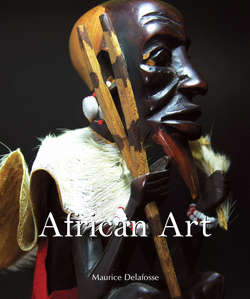Читать книгу African Art - Maurice Delafosse - Страница 13
На сайте Литреса книга снята с продажи.
Development of Negro Civilisations in Antiquity
“Aggry Beads”
ОглавлениеOne meets nearly everywhere in Africa, either in the tombs or in the tumuli reputed to be ancient, or on the bodies of the living who claim to have received them from their most distant ancestors, beads to which the Negroes attribute a very great value which strangely resemble in form, colouration and material, analogous beads worn by the Egyptians and with which they often decorated their mummies. In the 16th and 17th centuries, this sort of bead, generally cylindrical, was the object of an active commerce on the part of English and especially Dutch navigators, who bought them from the natives of the countries where they were relatively abundant and sold them at a profit in the countries where they were rarer. These navigators gave them the name of “pierres d‘aigris” or “aggry beads”, the exact origin of which is not known. At various times the glassworkers of Venice and of Bohemia have manufactured counterfeits by which the Negroes did not allow themselves to be deceived.
However it be, the presence among the African Negroes of these certainly very ancient beads, the value which they represent in their eyes and the mystery which surrounds their original provenance are not sufficient for forming a conclusion as to the existence of commercial relations between the Egypt of the Pharaohs and western and central Africa. On the one hand, in fact, Assyrian and Phoenician tombs contain identical beads, so that we are left perplexed as to the place of their manufacture and, in consequence, as to the point of departure which might be sought at Nineveh or Tyre as well as at Memphis. On the other hand, they have been found in northern Europe and eastern Asia, which indicates a considerable area of dispersion, certainly out of proportion to the limits which might be reasonably assigned to the influence of Egyptian civilisation.
In most of the countries where, even today, the Negroes find “aggry beads” by ransacking ancient burial places, there is a tradition that these beads have been imported by long-haired men of light colour who, according to legend, came from the sky and whom their congeners interred after decorating their corpses with the beads in question. At first this tradition suggested to me the possibility of caravan relations between the ancient Egyptians and populations as far removed from the Nile as those, for example, of the Gold Coast and the Ivory Coast. I have reflected since, that, if it be admitted that men of the white race, carriers of “aggry beads”, advanced at one time as far as those distant regions, it would be much more probable that they came from Berbery – in the geographical sense today given to the word – than from Egypt. It has not come to our knowledge that the Egyptians had a great amount of commerce with the Negroes, except those of the Nile valley from among whom they procured slaves for themselves, while at all times, as at the present, the inhabitants of what Herodotus called Libya and what we denominate as Berbery or the Barbary Coast (Tripoly, Tunisia, Algeria, Morocco) have not hesitated to cross the Sahara and to adventure as far as the Negroes to buy from them principally goldpowder in exchange for various sorts of merchandise. Among this merchandise, Arab geographer, Yakut mentions copper rings and blue glass beads as being very much in honour at his time, that is to say, at the beginning of the 13th century. More recently, the Negroes most admire and value “aggry beads” made of blue glass.
Statue, Katsina region, 1st-4th century CE. Nigeria.
Terracotta, height: 295 cm.
Protruding eyes and rounded features characterise the terracottas of the Katsina region. Here, the elongated neck emphasises its majestic head.
Jonyeleni female figure (Bamana).
Mali.
Wood, cotton, beads, string, iron, height: 65 cm.
Musée du quai Branly, Paris.
Statue, Kambari style (Dogon).
Wood, height: 34 cm.
Typical of Dogon art’s Kambari style, this statue represents an important time of a binu priest’s inauguration. Its acute stylisation is reinforced by the thick finish left behind by various libations of chicken blood and eggs.
Gelede mask (Yoruba).
Nigeria.
Wood, pigment, 36 × 35 cm.
Musée du quai Branly, Paris.
The Yoruba wear the gelede mask on their head. The lower part represents a face while the upper part depicts a scene.
